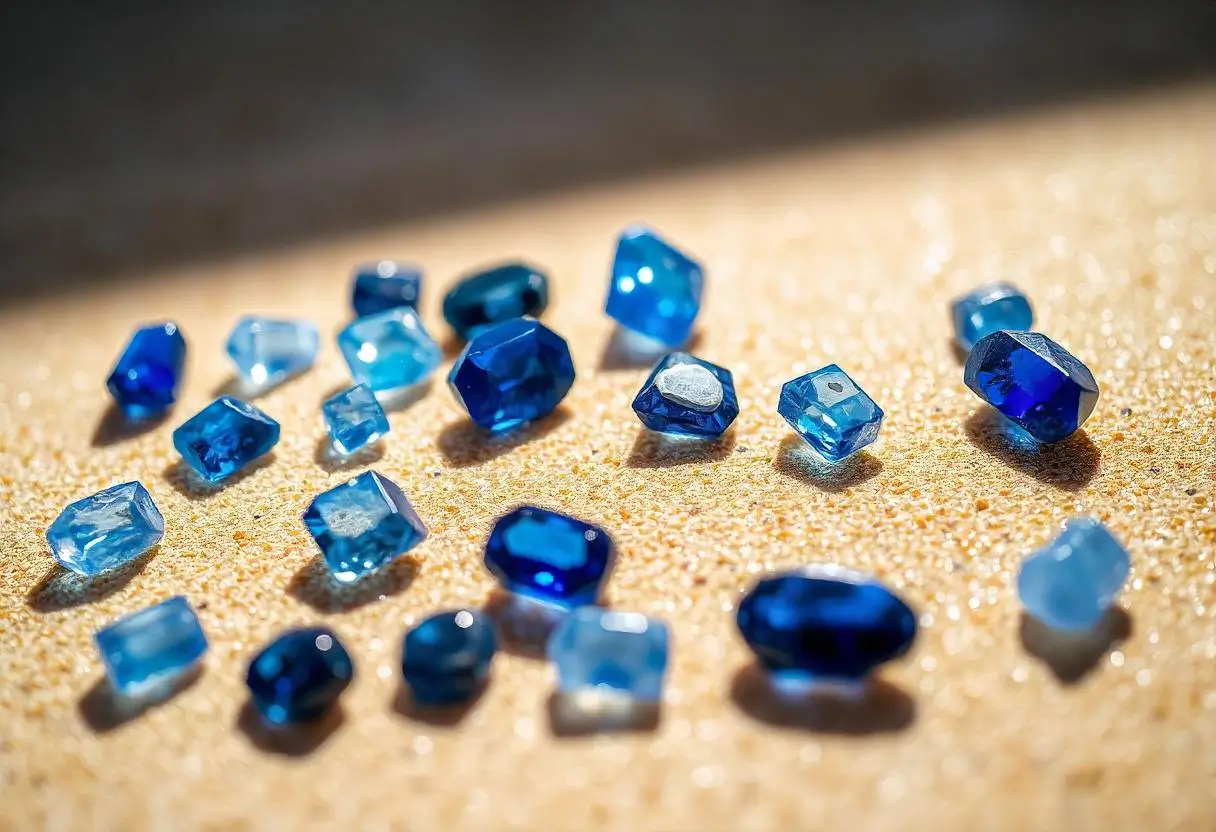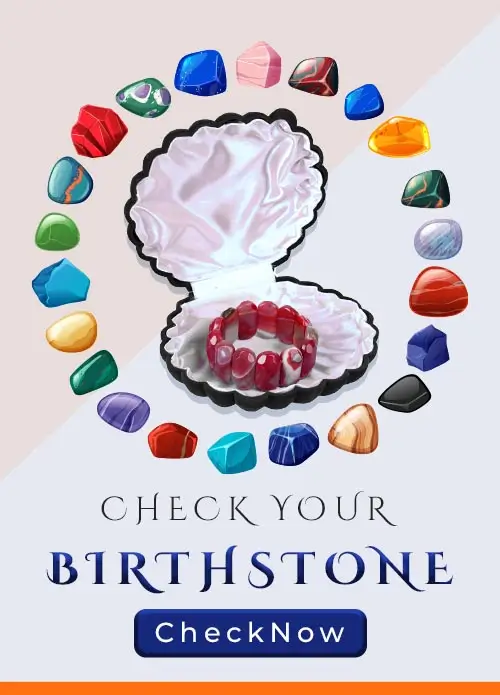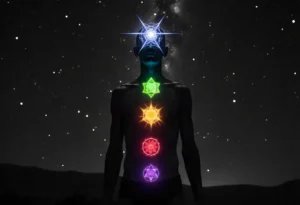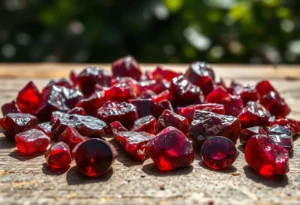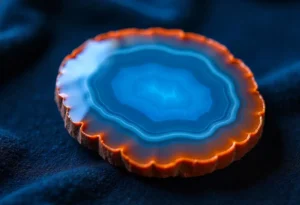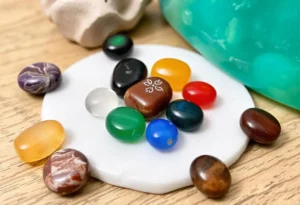Sapphire, a gem of timeless beauty, stands as the most iconic member of the corundum family. While famed for its deep blue hues, it dazzles in an array of colors, known as fancy sapphires. With unmatched durability and a legacy of symbolizing wisdom and protection, sapphire remains a cherished treasure in both history and modern jewelry.
Introduction to Sapphire
Sapphire is a gemstone that has captured the imagination of people for centuries, renowned for its vivid colors and enduring beauty. While blue is the most well-known hue, sapphire comes in a variety of colors, from pink and yellow to green and even colorless. It has long been admired not only for its aesthetic appeal but also for its exceptional hardness, making it an ideal choice for both fine jewelry and industrial applications. Whether worn as an engagement ring or admired in its natural crystal form, sapphire continues to be a symbol of timeless elegance.
What is Sapphire?
Sapphire is a precious gemstone that belongs to the corundum mineral family, which also includes ruby. It is primarily composed of aluminum oxide and gains its color through the presence of various trace elements. Although blue sapphires are the most famous, sapphires can be found in a wide range of colors, making them one of the most versatile gemstones in the world. Sapphires are highly valued for their brilliance, luster, and durability, making them popular choices for engagement rings, necklaces, and earrings. Their exceptional hardness, ranking at 9 on the Mohs scale, ensures that they can withstand everyday wear while maintaining their beauty for years to come.
The Legacy of Sapphire in History
Sapphire has a rich history that spans centuries and cultures. Ancient civilizations, including the Greeks and Romans, believed that sapphires possessed protective and healing properties. They were often worn by royalty, and the gemstone was considered a symbol of wisdom, nobility, and divine favor. In the Middle Ages, clergy would wear sapphire to represent purity and to invoke the favor of God. Over the centuries, sapphire has continued to be a gemstone of high esteem, worn by kings, queens, and influential figures worldwide. Its association with royalty continues to this day, with notable pieces like Princess Diana’s iconic engagement ring, which was later worn by Kate Middleton.

Characteristics of Sapphire
Sapphire is a gemstone renowned for its exceptional hardness, brilliant luster, and captivating colors. It has been revered for centuries for its beauty and durability, making it a sought-after choice for fine jewelry.
Sapphire’s Hardness and Durability
Sapphire belongs to the corundum family, ranking 9 on the Mohs scale of hardness. This places it just below diamonds, making sapphire one of the hardest gemstones in the world. Its remarkable hardness ensures that sapphire retains its beauty and integrity over time, even in everyday wear. Whether set in engagement rings, necklaces, or bracelets, sapphire’s durability ensures that it will withstand scratches and abrasions, maintaining its stunning appearance for generations.
Optical Properties: Brilliance and Luster
One of the defining features of sapphire is its optical properties, which contribute to its mesmerizing brilliance and luster. When cut and polished properly, sapphire exhibits remarkable brilliance, reflecting light in vibrant flashes. The stone’s high refractive index allows it to sparkle in any lighting, whether under natural sunlight or artificial light. Sapphire’s luster, a result of its high density and smooth surface, adds to its overall beauty, making it one of the most visually captivating gemstones available.
Chemical Composition and Trace Elements
Sapphire is primarily composed of aluminum oxide (Al2O3), a compound that forms the foundation of its incredible hardness. What makes sapphire unique, however, is the presence of trace elements like iron, titanium, and chromium, which give the gemstone its wide range of colors. Blue sapphires, for example, owe their vibrant hue to the presence of titanium and iron, while other colors like pink or yellow are created by different trace elements. The specific combination of these trace elements in the crystal structure of sapphire is what determines its color and character, making each sapphire truly one-of-a-kind.
The Many Colors of Sapphire
Sapphire, renowned for its wide array of colors, is a gemstone that offers an extraordinary palette for every taste. While blue sapphires are the most recognized and iconic, sapphires come in a stunning range of colors, each with its unique charm. From deep pinks to vibrant yellows and even the rare Padparadscha sapphire with its pink-orange hue, sapphires offer something for every gemstone enthusiast. Understanding the different colors of sapphire can help buyers choose the perfect stone for their collection or jewelry piece.
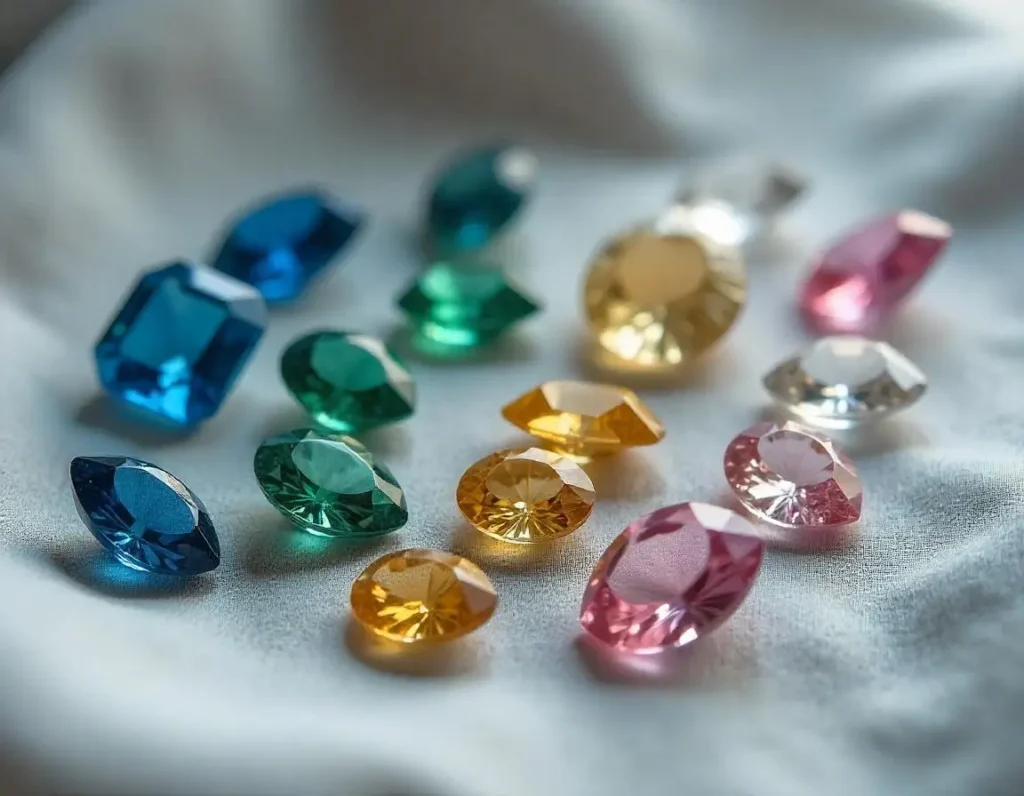
Blue Sapphire: The Iconic Choice
Blue sapphire is, without a doubt, the most famous and sought-after color of sapphire. Its captivating blue hue, often described as royal or cornflower blue, has made it the gemstone of choice for centuries. Blue sapphires symbolize wisdom, loyalty, and nobility, which is why they have been a favorite among royalty and the aristocracy. The color of blue sapphire can vary, ranging from light blue to deep, velvety blue, with the most prized sapphires being those with a rich, intense blue hue that is neither too dark nor too light.
Fancy Sapphires: A Kaleidoscope of Colors
Fancy sapphires refer to any sapphire that isn’t blue, showcasing the gemstone’s versatility in color. These sapphires come in a rainbow of hues, including pink, yellow, green, and even colorless varieties. Fancy sapphires are gaining popularity for their uniqueness and stunning appearance. While blue sapphires dominate the market, fancy sapphires are now being increasingly sought after for their individuality and beauty. These stones, with their diverse colors, offer gemstone enthusiasts the chance to own a sapphire that is truly one-of-a-kind.
Pink Sapphire
Pink sapphire, with its delicate and romantic hue, is one of the most loved fancy sapphires. Ranging from soft pastel pinks to vibrant, hot pinks, pink sapphires are often associated with love and passion. The color intensity of pink sapphires can vary, with deeper, more intense pinks being rarer and more expensive. These sapphires are often chosen for engagement rings and other fine jewelry due to their romantic and timeless appeal.
Yellow Sapphire
Yellow sapphires exude warmth and radiance, often resembling the sun’s golden glow. This type of sapphire ranges from pale yellow to deep, canary yellow, and is known for its vibrant color and brilliance. Yellow sapphires are traditionally believed to bring good fortune and wealth and are commonly used in various cultures as a symbol of prosperity and success. They are also a popular choice in engagement rings and other fine jewelry for those seeking a distinctive, cheerful gemstone.
Green Sapphire
Green sapphires, though less common, are a striking and rare variant of this precious gemstone. Ranging from light, minty greens to deep, forest hues, green sapphires are valued for their unique and earthy appearance. Green sapphires are often compared to emeralds due to their similar hue, though sapphires are generally harder and more durable. These stones are particularly appreciated for their versatility, working beautifully in both modern and vintage-style jewelry.
Padparadscha Sapphire (Pink-Orange Blend)
Padparadscha sapphires are one of the rarest and most coveted variations of sapphire, known for their unique pink-orange hue. These sapphires are highly prized for their exceptional color, which is often described as a blend of the soft pink of a rose and the warm orange of a sunset. Their rarity and captivating color make them one of the most expensive types of sapphire. Padparadscha sapphires are highly sought after by collectors and jewelry enthusiasts alike for their unparalleled beauty and distinctive hue.
Understanding Color Zoning and Pleochroism in Sapphires
Sapphires are known for their pleochroism, which is the ability of the gemstone to show different colors when viewed from different angles. This optical property often leads to the fascinating phenomenon of color zoning, where a sapphire may exhibit different hues or shades within the same stone. Pleochroism and color zoning can make a sapphire appear more dynamic and vibrant, as the stone’s color shifts depending on the direction of the light. Understanding these traits is essential when evaluating sapphires, as they can affect the overall appearance and value of the gemstone.
Origins and Sources of Sapphires
Sapphires, renowned for their stunning beauty, are sourced from various locations around the world. Each region offers unique characteristics that affect the quality and color of the sapphires found there. Sapphire mining has a rich history, with some regions being particularly famous for producing high-quality stones that are highly sought after in the jewelry market. Understanding where sapphires are mined can help you appreciate the rarity and value of different sapphires.
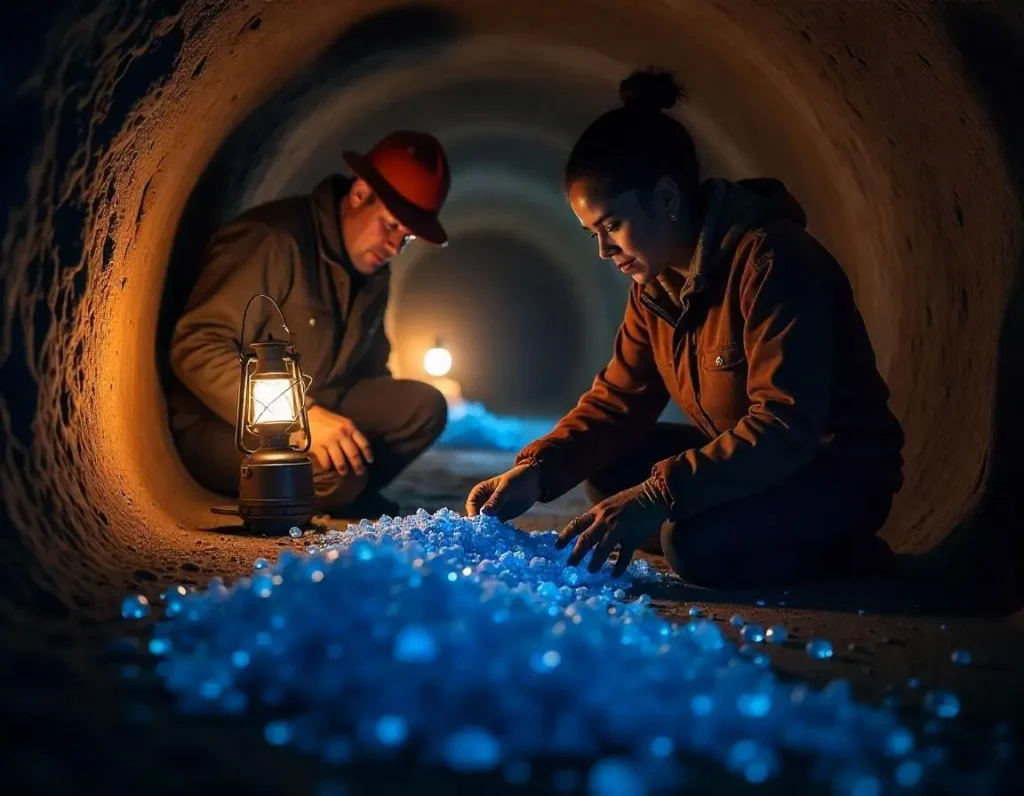
Sapphire Mining Locations Worldwide
Sapphires are found in many countries across the globe, each contributing to the global supply of these precious gemstones. Some countries have long histories of sapphire mining and have become synonymous with specific types of sapphires. From the hills of Sri Lanka to the rich deposits in Australia, sapphire mines have helped shape the gemstone market. The quality, color, and size of sapphires vary significantly depending on the location where they are mined, making sapphire origin a crucial factor in determining their value.
Kashmir Sapphires
Kashmir sapphires are some of the most prized and famous sapphires in the world. Mined from the rugged mountain region of Kashmir in northern India, these sapphires are known for their rare and exquisite velvety blue hue. The color of Kashmir sapphires is often described as the perfect blue, with a soft, rich tone that is deeply sought after. Due to the limited quantity of sapphires mined in Kashmir and the region’s challenging terrain, these sapphires are incredibly rare and command high prices on the market. Kashmir sapphires are considered among the best in the world due to their exceptional color and rarity.
Sri Lankan (Ceylon) Sapphires
Sri Lanka, historically known as Ceylon, is one of the oldest and most significant sapphire mining regions in the world. The island nation produces sapphires in various colors, with blue sapphires being the most famous. Sri Lankan sapphires are prized for their clarity, brilliance, and wide range of shades, from light blues to deeper, more vibrant blues. Sri Lanka’s sapphire mines are also known for producing a variety of fancy sapphires, including pink, yellow, and green sapphires. The country’s rich sapphire history and the consistent quality of its stones have made Sri Lankan sapphires a staple in the global gemstone market.
Burmese Sapphires
Burmese sapphires, particularly those from Myanmar, are another highly regarded source of quality sapphires. Known for their deep blue color and incredible clarity, Burmese sapphires have long been considered among the finest in the world. Myanmar’s mining regions, such as Mogok, have been producing sapphires for centuries. These sapphires are often characterized by a slightly darker, more intense blue than their Sri Lankan counterparts, making them desirable for those who seek a richer hue. Burmese sapphires also have historical significance, having been worn by royalty and used in high-end jewelry designs for centuries.
Madagascan Sapphires
Madagascar has recently emerged as a major source of sapphires, with significant deposits found across the island. Known for producing sapphires in a wide range of colors, including blue, pink, green, and even color-changing sapphires, Madagascar’s mines have rapidly gained global attention. The country’s sapphires are typically prized for their large sizes and striking color saturation. Madagascar has become one of the world’s leading suppliers of sapphires, and its gemstones are highly sought after by jewelers around the world for their diversity and affordability compared to sapphires from other regions.
Australian Sapphires
Australia is home to some of the largest sapphire deposits in the world. The country’s sapphires are predominantly found in the regions of Queensland and New South Wales. Australian sapphires come in various colors, with blue and green sapphires being the most popular. While Australian sapphires may not always match the depth of color seen in those from Kashmir or Myanmar, they are known for their excellent durability and size. The country is also famous for producing beautiful star sapphires, which feature a star-shaped pattern due to inclusions within the gemstone. Australian sapphires are highly valued for their affordability and versatility in jewelry design.
Sapphire Mining in Pakistan
Pakistan has become an increasingly important player in the sapphire market, particularly in regions such as Gilgit-Baltistan. The country’s mountainous terrain and rich geological makeup make it an ideal location for sapphire deposits. While Pakistan’s sapphires may not yet rival those from traditional mining regions such as Kashmir or Myanmar, they are gaining recognition for their stunning colors and clarity. Pakistani sapphires are typically found in shades of blue, with some stones exhibiting exceptional brilliance. As the mining industry in Pakistan grows and more sapphires are unearthed, the country is expected to become a significant source of high-quality sapphires in the global market.
Spiritual and Symbolic Significance of Sapphires
Sapphires, revered for their natural beauty and rarity, have held symbolic significance across many cultures throughout history. These stunning gemstones are not only admired for their color and brilliance but also for their spiritual and symbolic meanings. Associated with qualities such as loyalty, wisdom, and purity, sapphires have been used in various spiritual and metaphysical practices. For centuries, they have been believed to provide protection, enhance intellectual abilities, and bring inner peace to their wearers. Let’s explore the spiritual and symbolic significance of sapphires, both the iconic blue sapphire and its colorful counterparts.
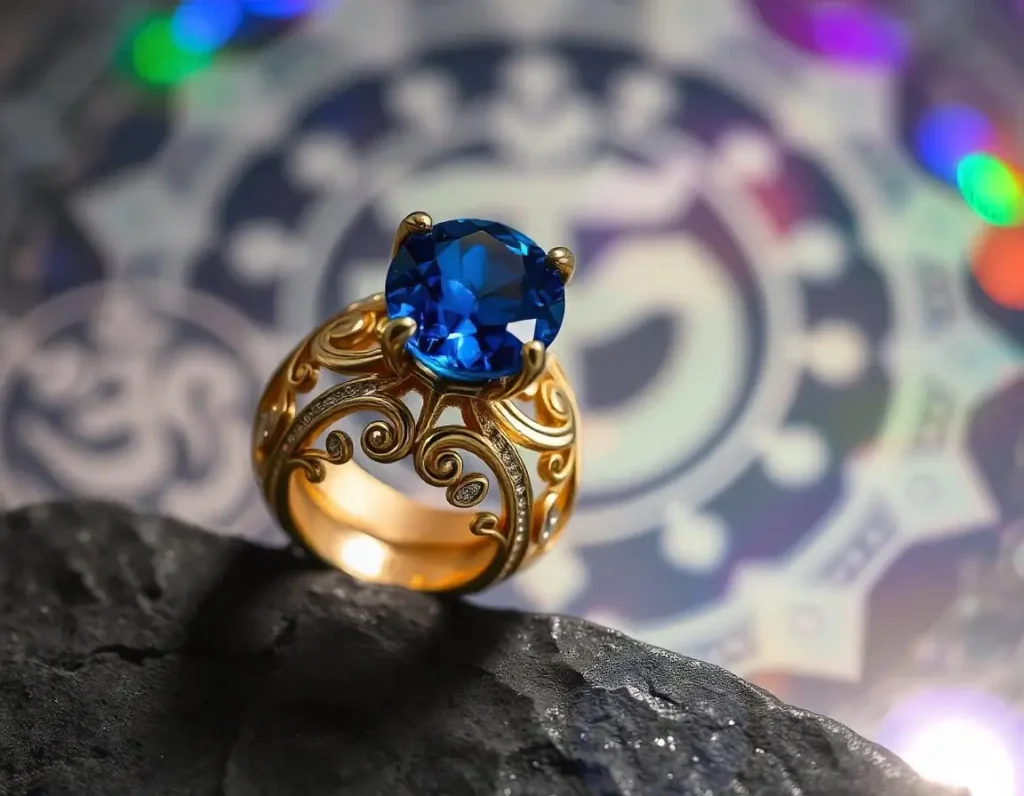
The Symbolism of Blue Sapphire: Loyalty and Wisdom
Blue sapphire, the most iconic and widely recognized color of sapphire, has long been a symbol of loyalty, wisdom, and nobility. Ancient cultures believed that wearing a blue sapphire would protect the wearer from envy and harm, while also fostering spiritual growth and enhancing clarity of thought. In many traditions, blue sapphires were thought to bring harmony and balance, offering a calming effect to the mind and body. Historically, blue sapphires were also associated with royalty and were often set in crowns and other regal jewelry as a symbol of divine favor and wisdom. The deep, serene blue of the sapphire is thought to represent a connection to the heavens and a source of divine guidance.
Spiritual Benefits of Fancy Sapphires
While blue sapphire may be the most famous, fancy sapphires—those in shades of pink, yellow, green, and other vibrant colors—also carry their own spiritual benefits. Each color of sapphire is believed to resonate with different energies and offer unique healing properties. For example, pink sapphires are thought to encourage love, compassion, and emotional healing, while yellow sapphires are associated with abundance, prosperity, and personal growth. Green sapphires are linked to fertility, healing, and emotional stability. By wearing or meditating with these fancy sapphires, individuals may experience an enhancement of the specific qualities tied to the gemstone’s color, helping them achieve balance, prosperity, and healing in their lives.
Sapphire’s Role in Astrology
In astrology, sapphires hold a significant place, particularly in the context of planetary influences. Blue sapphires are most commonly linked to the planet Saturn, which is associated with discipline, structure, and responsibility. Astrologers believe that wearing a blue sapphire can bring strength, wisdom, and protection against negativity. For those whose birth charts indicate a strong connection to Saturn, the gemstone is often recommended to help balance their energy and support their personal growth. Additionally, fancy sapphires, like yellow and pink, are sometimes connected to other planets—yellow sapphires are associated with Jupiter, the planet of luck and expansion, while pink sapphires are connected to Venus, the planet of love and beauty. Wearing or meditating with sapphires, according to astrological beliefs, can help individuals align with the positive energies of the planets and enhance various aspects of their lives, from love and wealth to health and well-being.
Benefits and Uses of Sapphires
Sapphires are more than just visually captivating gemstones; they are believed to offer numerous benefits, both physical and emotional. Throughout history, sapphires have been cherished for their healing properties, as well as their ability to inspire positive changes in the wearer’s life. Known for their association with wisdom, loyalty, and protection, sapphires are also considered powerful stones that can improve well-being on various levels. Below, we explore the many benefits and uses of sapphires, including their emotional and mental healing properties, as well as their importance in fine jewelry.
Sapphire for Emotional and Mental Well-being
Sapphires, particularly blue sapphires, are known for their calming and soothing properties, making them highly beneficial for emotional well-being. They are believed to help alleviate stress, anxiety, and depression by bringing clarity to the mind and promoting inner peace. Many wearers report feeling more grounded and centered when surrounded by the energy of sapphires. These gemstones are said to clear mental clutter, enabling individuals to focus on what truly matters. Additionally, sapphires are thought to open the third eye and throat chakras, enhancing communication, self-expression, and mental clarity. As such, sapphire can be a powerful ally for those seeking emotional healing and mental balance.
Healing Properties of Sapphire
In addition to their emotional and mental healing qualities, sapphires are believed to have physical healing benefits. They are often associated with promoting overall health and vitality, especially when it comes to the circulatory and immune systems. Sapphire is also thought to help with healing ailments related to the skin, particularly in cases of rashes, bruises, and inflammation. Many people turn to sapphires to aid in detoxification, as the stone is said to promote purification of the body and mind. Additionally, sapphire is believed to support spiritual growth by enhancing one’s intuition and connection to higher consciousness. Whether worn as jewelry or used in meditation practices, sapphires are revered for their holistic healing properties that nurture the mind, body, and spirit.
Sapphire in Jewelry: Engagement Rings, Necklaces, and More
Sapphires have been a popular choice in jewelry for centuries due to their durability, beauty, and timeless appeal. The gemstone’s stunning colors, particularly the iconic blue, make it a perfect addition to engagement rings, necklaces, bracelets, and earrings. Sapphire’s hardness, ranking 9 on the Mohs scale, ensures that it is a resilient and long-lasting choice for daily wear. As a result, sapphire engagement rings have become a symbol of enduring love and commitment. Many royal families, including the British monarchy, have famously chosen sapphires for their engagement rings, further cementing the gemstone’s association with royalty and elegance. Apart from engagement rings, sapphires are also commonly set in necklaces, earrings, and other fine jewelry pieces, making them versatile and sophisticated choices for any occasion.
Sapphire’s rich history in jewelry design, coupled with its wide range of available colors—ranging from deep blues to vibrant pinks, yellows, and even rare green sapphires—means that there is a sapphire for every taste and style. Whether you’re seeking a classic blue sapphire ring or a more unusual fancy sapphire piece, the gemstone’s brilliance and timeless beauty will continue to make it a favorite among jewelry lovers.
Types of Sapphire Cuts and Shapes
Sapphires are one of the most versatile gemstones, available in a wide range of cuts and shapes. The cut of a sapphire not only enhances its natural beauty but also contributes to its brilliance and overall appeal. Different cuts can highlight the unique colors and properties of the gemstone, and they are often selected based on the intended jewelry piece. Whether you’re looking for a classic engagement ring or a statement necklace, choosing the right sapphire cut can significantly impact the gemstone’s appearance and the piece’s overall aesthetic.
Round, Oval, and Cushion Cuts
Among the most popular cuts for sapphires are the round, oval, and cushion cuts. These timeless shapes have been favored in fine jewelry for their ability to enhance the gemstone’s brilliance and maximize its color depth.
- Round Cut: The round cut is perhaps the most classic and widely recognized sapphire cut. Known for its symmetry and brilliance, the round shape allows the sapphire to reflect light from every angle, giving it an eye-catching sparkle. This cut is highly popular for engagement rings and can be set in various settings, from solitaire designs to halo settings.
- Oval Cut: The oval cut is a sophisticated alternative to the round shape, offering a more elongated and elegant look. This cut is ideal for those who prefer a gemstone that appears larger than a round-cut sapphire of the same carat weight. Its elongated shape also complements many different styles of jewelry, adding a graceful touch to any design.
- Cushion Cut: The cushion cut combines elements of both the round and square cuts, offering a soft, rounded shape with a squared-off edge. Known for its romantic and vintage appeal, the cushion cut has rounded corners and a brilliant facet pattern that makes the sapphire sparkle with a soft, warm glow. The cushion shape is often chosen for engagement rings and statement pieces due to its timeless and charming appearance.
Unique Cuts for Fancy Sapphires
Fancy sapphires, with their wide array of colors, often benefit from unique and creative cuts that further enhance their beauty. These cuts are tailored to highlight the individual hues and characteristics of fancy sapphires, which may include shades of pink, yellow, green, and even the rare Padparadscha (a pink-orange blend).
- Emerald Cut: The emerald cut, with its long, rectangular facets and step-cut design, is perfect for showcasing the clarity and color of a fancy sapphire. This cut is often chosen for sapphires with a higher clarity grade, as it emphasizes the gemstone’s inner brilliance and natural luster.
- Princess Cut: The princess cut is a square-shaped cut with sharp corners, and it’s particularly popular for fancy sapphires due to its ability to reflect light brilliantly. This cut is favored for engagement rings and other fine jewelry, as it offers a modern and chic appearance while retaining the sapphire’s vibrant color.
- Heart Cut: The heart-shaped sapphire is a symbol of love and passion, making it a popular choice for romantic jewelry. This unique cut can highlight the deep, rich color of a sapphire, particularly in fancy hues like pink and violet. It’s a truly distinctive and memorable shape that adds an extra layer of sentimentality to any piece of jewelry.
- Trillion Cut: The trillion cut is a triangular shape that brings out the brilliance and fire of a sapphire. It’s an excellent choice for fancy sapphires, as the cut can intensify the color of the gemstone and add a modern, sharp look to rings and earrings.
- Radiant Cut: The radiant cut is another option for fancy sapphires, blending the best qualities of both the emerald and round cuts. Its facets allow the gemstone to sparkle in a way that enhances both color and brilliance, making it a great choice for showcasing fancy sapphires in all their vibrant hues.
Each of these unique cuts plays a significant role in emphasizing the specific characteristics of fancy sapphires. Whether you’re selecting a classic blue sapphire or one in a rare color, choosing the right cut can elevate the gemstone’s natural beauty and create a piece of jewelry that is truly one-of-a-kind.
The Rarity of Star Sapphires and Cat’s Eye Effect
Sapphires are prized for their beauty and brilliance, but two unique phenomena—star sapphires and cat’s eye sapphires—take the gemstone’s allure to extraordinary levels. These rare sapphire varieties possess remarkable visual effects that make them highly sought after in the world of fine jewelry.
Star Sapphires: A Celestial Wonder
Star sapphires are incredibly rare and unique stones that display a captivating star-shaped pattern on their surface. This phenomenon occurs due to the presence of needle-like inclusions of a mineral called rutile within the sapphire. When viewed under a direct light source, these rutile inclusions reflect and scatter light in such a way that a star-like figure emerges on the surface of the sapphire, giving it a mesmerizing, celestial appearance.
The star effect typically has six rays, but some star sapphires can display twelve or even twenty-four rays, depending on the orientation of the rutile inclusions. This optical effect, known as asterism, is most striking in cabochon-cut sapphires. Unlike traditional faceted sapphires, which emphasize the stone’s brilliance, cabochon-cut star sapphires have a smooth, rounded top that enhances the star effect. The rarity of star sapphires is attributed to the fact that they require very specific conditions to form, with the rutile inclusions being naturally aligned in a particular way.
Star sapphires are available in various colors, including the traditional blue and other hues like pink, black, and yellow. Among them, the blue star sapphire is the most coveted, as it reflects the most vivid and prominent star pattern. Due to their rarity and unique visual appeal, star sapphires are often featured in statement jewelry pieces like rings, pendants, and brooches.
Cat’s Eye Sapphires: The Feline’s Gaze
The cat’s eye effect in sapphires is another extraordinary feature that enhances the gemstone’s rarity and desirability. Much like the reflective, vertical slit in a cat’s eye, the cat’s eye sapphire exhibits a sharp, glowing band of light across its surface. This phenomenon, known as chatoyancy, is caused by needle-like inclusions of minerals like rutile or fibrous inclusions that run parallel to the stone’s surface. These inclusions interact with light, creating a distinct, silky glow that moves as the sapphire is rotated—resembling the slit pupil of a cat’s eye.
Cat’s eye sapphires are typically cut into cabochon shapes to maximize the visibility of the chatoyancy effect. The most prized cat’s eye sapphires display a clear, focused band of light across the surface, ideally located at the center of the gemstone. While the effect can occur in various gemstones, sapphire cat’s eyes are among the most valuable, particularly when the eye effect is well-defined and the sapphire itself is of high quality.
The cat’s eye effect is most commonly found in yellow, green, and gray sapphires, although it can also appear in other colors, including blue. The appeal of cat’s eye sapphires lies in their mystical allure and the rare, dynamic quality they bring to jewelry pieces.
Why Are Star and Cat’s Eye Sapphires So Rare?
The rarity of star sapphires and cat’s eye sapphires lies in the conditions required for their formation. Both effects depend on the presence of certain inclusions in specific orientations, which is not commonly found in all sapphires. These gemstones are also quite rare in the market, as only a small percentage of sapphires exhibit the star or cat’s eye effect strong enough to be considered valuable.
Star sapphires and cat’s eye sapphires are highly coveted by collectors and gemstone enthusiasts, and their rarity significantly drives up their price. Jewelry designers often seek these rare stones to create unique and eye-catching pieces that stand out for their extraordinary optical effects.
Whether it’s the enchanting star pattern or the hypnotic cat’s eye glow, these sapphires provide a connection to something magical, and their rarity only adds to their appeal. Owning a star sapphire or a cat’s eye sapphire is truly a privilege, as these gemstones bring both beauty and mystique into the world of fine jewelry.
Sapphire Pricing Guide
Sapphires are one of the most sought-after gemstones in the world. Known for their stunning beauty, durability, and rich colors, sapphires are prized in fine jewelry. However, the price of sapphires can vary significantly depending on several key factors. Understanding these factors can help you make an informed decision when purchasing a sapphire. In this section, we will explore the primary elements that influence sapphire pricing and provide insights into the current sapphire prices in Pakistan.
Factors Affecting Sapphire Prices
Sapphire prices are determined by various elements that influence their overall value. The following are the main factors that play a crucial role in determining the price of a sapphire:
Color and Hue
The most important factor affecting sapphire prices is its color. While sapphires come in a range of colors, the most coveted is the deep, vibrant blue sapphire. The color of a sapphire is graded based on its hue, tone, and saturation. Blue sapphires with a vivid, rich color are highly prized, especially those that display a pure blue with no visible traces of gray or green.
Fancy sapphires, which come in various colors such as pink, yellow, green, and padparadscha, also vary in price based on their specific hue. For example, Padparadscha sapphires, which have a unique blend of pink and orange, are considered especially rare and thus can command much higher prices than other fancy sapphires.
The depth of color is essential—sapphires that are too dark or too light in color may be less valuable. Therefore, the ideal sapphire has a balance of color saturation, which is neither too pale nor too dark.
Clarity and Transparency
Sapphires are natural gemstones that often contain inclusions—small internal features or imperfections—known as blemishes or fingerprints. The fewer the inclusions, the more valuable the sapphire becomes. A clean sapphire with minimal to no inclusions is much rarer and will fetch a higher price.
The clarity of the sapphire can be evaluated using a clarity scale, which grades the gemstone based on the presence of visible inclusions when viewed under magnification. Sapphires with excellent clarity are generally more expensive. On the other hand, sapphires with noticeable inclusions or imperfections may have a lower price, but they still hold great value depending on their other qualities, such as color.
Origin and Certification
The origin of a sapphire plays a significant role in determining its price. Some locations are renowned for producing higher-quality sapphires, which are often priced higher due to their reputation. For example, Kashmir sapphires are considered some of the finest in the world, known for their rich, velvety blue color. Ceylon sapphires (from Sri Lanka) are also highly regarded, known for their bright, lively hues.
In addition to origin, certification by trusted gemological institutions, such as GIA (Gemological Institute of America), can affect the price of a sapphire. Certified sapphires come with detailed reports on their color, clarity, cut, and other characteristics, ensuring transparency and authenticity. Sapphires with certification are generally priced higher as they provide added confidence to buyers.
Sapphire Price in Pakistan (2023–2024)
The sapphire market in Pakistan has seen a steady growth in recent years. Pakistan is home to some sapphire-producing regions, particularly in Kashmir and Gilgit-Baltistan. Due to the rich history of sapphire mining in these areas, local sapphires are highly sought after by collectors and jewelers alike.
Price of Blue Sapphire in Pakistan
The price of blue sapphires in Pakistan can vary significantly based on their quality. In 2023–2024, the price of a high-quality blue sapphire typically ranges between PKR 5,000 to PKR 20,000 per carat. Sapphires with deeper, more intense blue hues and excellent clarity often cost at the higher end of the scale.
Imported blue sapphires, especially those from renowned locations like Kashmir or Ceylon, may cost even more, depending on their provenance and quality.
Price of Fancy Sapphires
Fancy sapphires, which include sapphires in colors such as pink, yellow, and green, tend to be more affordable than blue sapphires, but their price can also fluctuate depending on their color, quality, and rarity. For instance, Padparadscha sapphires, which have a unique pink-orange color, are one of the rarest and most expensive fancy sapphires.
In Pakistan, the price for fancy sapphires typically ranges between PKR 4,000 to PKR 15,000 per carat, depending on factors such as clarity, color, and cut. Certain fancy sapphires, especially rare ones like Padparadscha, can command much higher prices due to their scarcity.
Conclusion
When purchasing a sapphire, whether it’s a blue sapphire, a fancy sapphire, or a rare star sapphire, understanding the factors that affect its price is essential. Color, clarity, origin, and certification all play a critical role in determining a sapphire’s value. In Pakistan, sapphires can range in price, with blue sapphires typically fetching higher prices due to their intense color and clarity, while fancy sapphires provide more affordable alternatives.
Knowing what affects sapphire pricing will help you make an informed purchase, whether you’re looking for an investment piece or a beautiful gemstone for your jewelry collection. Always remember to consider the sapphire’s unique characteristics, and if you’re buying a sapphire for its beauty and rarity, it will certainly be a timeless treasure.
Sapphire in the Corundum Family
Sapphires belong to the illustrious corundum family, a mineral group known for producing some of the world’s most exquisite gemstones. Composed primarily of aluminum oxide (Al₂O₃), corundum achieves its dazzling array of colors through trace elements that infiltrate its crystal lattice during formation. Among the corundum gemstones, sapphires and rubies are the most notable members, celebrated for their beauty, durability, and symbolic significance.
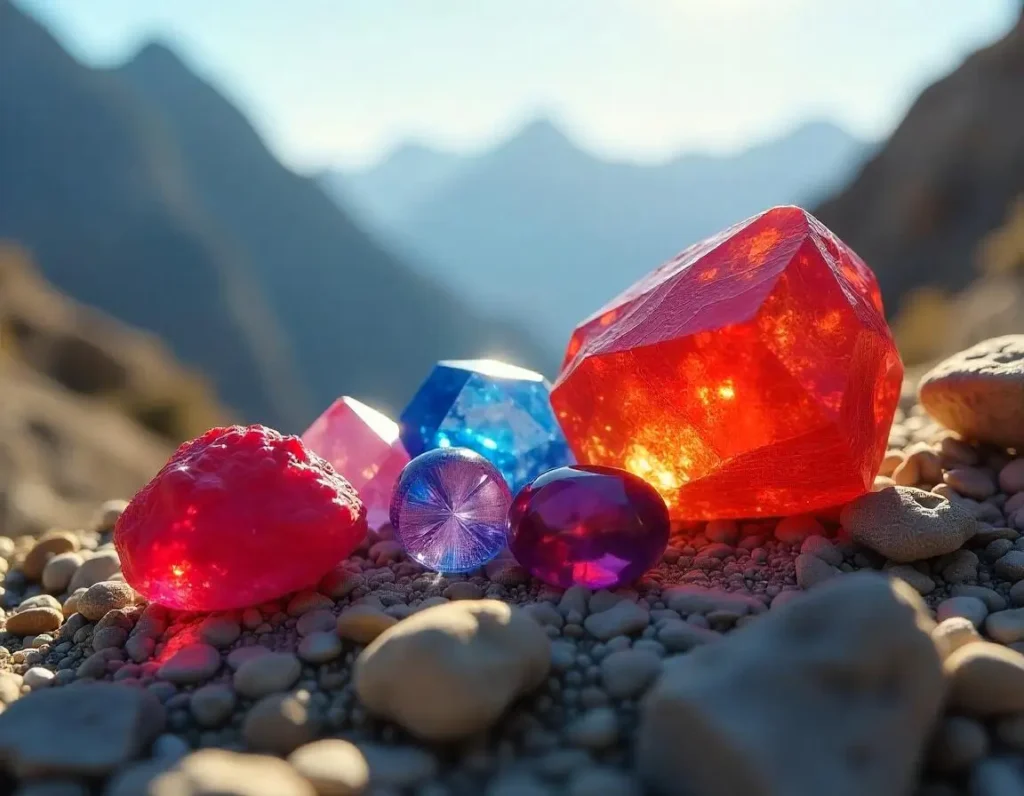
Sapphire vs. Ruby: Key Differences
While both sapphires and rubies share the same mineral composition, their distinction lies in color. The presence of chromium gives rubies their fiery red hues, while iron and titanium are responsible for the mesmerizing blues and other colors of sapphires. Essentially, a sapphire could be thought of as any gem-quality corundum that isn’t red (ruby).
Additionally, the cultural and symbolic associations differ between the two. Rubies are often linked to passion and vitality, while sapphires symbolize wisdom, loyalty, and tranquility. Despite their differences, both gemstones share exceptional hardness (9 on the Mohs scale) and are highly prized in the gemstone market.
The Role of Corundum in Gemstone Formation
Corundum forms under specific geological conditions, requiring high temperatures and pressures. Found primarily in igneous and metamorphic rocks, the formation process is influenced by the surrounding minerals and trace elements. These elements imbue corundum with its distinct colors, creating the beautiful array of sapphires, from the classic blue sapphire to vibrant fancy colors such as pink, yellow, and green.
Certain regions like Kashmir, Sri Lanka, and Burma provide optimal conditions for producing high-quality corundum. These areas are renowned for yielding some of the finest sapphires and rubies, further enhancing their reputation as coveted treasures of the corundum family.
By understanding the geological and compositional nuances of corundum, gemstone enthusiasts can appreciate the incredible journey that sapphires and rubies take from the depths of the Earth to becoming symbols of elegance and sophistication.
Caring for Your Sapphire Jewelry
Sapphire jewelry is a timeless investment, cherished for its beauty and durability. However, proper care is essential to preserve its brilliance and protect it from damage over time. By following some simple maintenance tips, you can ensure your sapphire jewelry remains as stunning as the day you acquired it.
Cleaning and Maintenance Tips
To clean sapphire jewelry, use a solution of lukewarm water and mild dish soap. Soak the jewelry for 15–20 minutes, then gently scrub it with a soft-bristled toothbrush to remove dirt and grime. Rinse thoroughly with clean water and pat dry with a soft, lint-free cloth.
Avoid harsh chemicals, such as bleach or ammonia, as they can erode the metal setting and diminish the gemstone’s luster. For deeper cleaning, consider taking your jewelry to a professional jeweler who can use ultrasonic or steam cleaning methods, provided your sapphire is free of any fractures or inclusions.
Safeguarding Against Damage
While sapphires are among the hardest gemstones, they are not impervious to damage. To prevent scratches or chips, store your sapphire jewelry separately in a soft cloth pouch or lined jewelry box. Avoid keeping it with harder gemstones like diamonds that could scratch its surface.
Remove your sapphire jewelry before engaging in activities such as cleaning, swimming, or exercising, as exposure to harsh chemicals, sweat, and physical impact can weaken the metal setting or damage the gemstone.
By incorporating these simple care practices, your sapphire jewelry will continue to dazzle for generations to come.
Buying Tips for Sapphires
Purchasing a sapphire requires careful consideration to ensure authenticity and value. With the wide range of options available, being well-informed can help you make a confident decision.
How to Identify Authentic Sapphires
Authentic sapphires are characterized by their durability, brilliance, and unique inclusions, often referred to as “birthmarks.” To identify a genuine sapphire:
- Check for Hardness: Sapphires rank 9 on the Mohs scale, making them resistant to scratches. A simple scratch test (performed by professionals) can confirm this.
- Observe the Color: Natural sapphires display a rich, even color. Synthetic stones may look unnaturally vivid or overly perfect.
- Look for Inclusions: While flawless sapphires exist, most natural stones have slight inclusions visible under magnification. Synthetic or treated stones may appear too perfect.
- Seek Professional Testing: Jewelers can use specialized tools to verify the stone’s authenticity and assess its origin.
What to Look for in a Sapphire Certificate
A gemstone certificate is crucial for verifying the quality and authenticity of your sapphire. Ensure the certificate is issued by a reputable gemological institute, such as the Gemological Institute of America (GIA) or American Gemological Laboratories (AGL).
Key details to look for in the certificate include:
- Origin: Identifies where the sapphire was mined, which can influence its value.
- Treatment Disclosure: Indicates whether the stone has undergone heat treatment or other enhancements.
- Color Grade: Describes the gemstone’s hue, saturation, and tone.
- Clarity and Cut: Assesses the inclusions and craftsmanship.
- Carat Weight: Confirms the stone’s size and weight.
By understanding these factors and relying on certified documentation, you can confidently select a sapphire that matches your expectations and budget.
FAQs About Sapphire
What is the Most Expensive Sapphire?
The most expensive sapphire is typically the Kashmir sapphire, renowned for its unparalleled cornflower blue hue and velvety texture. Mined in the Himalayan region of Kashmir, these stones are rare and highly coveted, often fetching millions of dollars per carat in auctions and high-end markets.
Beyond Kashmir sapphires, large, untreated Padparadscha sapphires (featuring a pink-orange blend) are also extremely valuable due to their rarity and unique color.
Are Fancy Sapphires as Valuable as Blue Sapphires?
While blue sapphires are the most iconic and sought-after, fancy sapphires in unique hues like pink, yellow, or green can also command high prices, particularly if they are untreated and exhibit vibrant, even color. The value of a fancy sapphire depends on factors like rarity, color saturation, and origin.
For example, Padparadscha sapphires, often classified as fancy sapphires, are considered more valuable than many blue sapphires due to their scarcity. However, less vibrant or treated fancy sapphires may not reach the same price levels as high-quality blue sapphires.
Where Can I Buy Genuine Sapphires in Pakistan?
You can purchase authentic sapphires from reputable gemstone dealers and jewelers in Pakistan. Cities like Peshawar, Islamabad, and Karachi are home to trusted markets where sapphires are sourced and sold.
To ensure authenticity:
- Choose dealers with a strong reputation and customer reviews.
- Request a gemstone certificate from recognized gemological labs.
- Verify the stone’s origin, as Pakistan itself is known for producing quality sapphires, particularly in regions like Azad Jammu and Kashmir (AJK).
Online platforms and specialized gemstone exhibitions in Pakistan are also excellent options for finding genuine sapphires.
Conclusion
Why Sapphire is the Perfect Gemstone for Any Occasion
Sapphire’s timeless allure, unparalleled durability, and vast array of colors make it a gemstone like no other. Whether you’re looking for a striking blue sapphire for a classic engagement ring or a fancy sapphire in pink, yellow, or green to showcase your unique style, this gem has something for everyone. Its symbolism of wisdom, loyalty, and prosperity adds a layer of meaning that makes it not just a gemstone, but a treasure with personal significance. Perfect for any occasion, sapphire remains a versatile and meaningful choice for jewelry lovers worldwide.
Explore More About the Corundum Family
Sapphire is just one dazzling member of the Corundum family, which also includes the fiery and passionate ruby. Both stones are formed from the same mineral but take on different hues due to trace elements, making them equally fascinating yet distinct. If you’re captivated by the beauty and rarity of sapphire, exploring other corundum gemstones can deepen your appreciation for nature’s artistry. Check out our other articles on the Corundum family to learn more about these remarkable gems.

